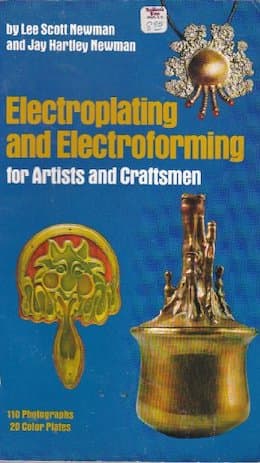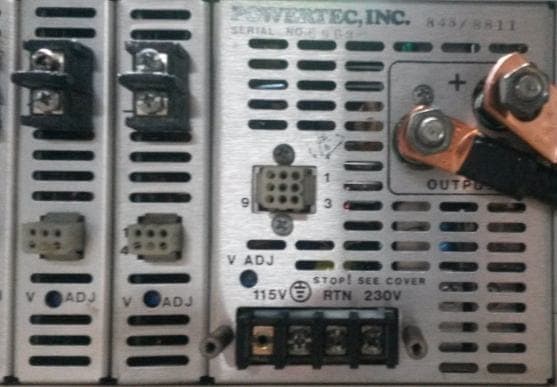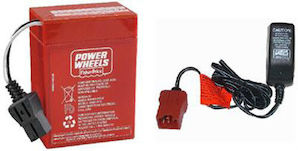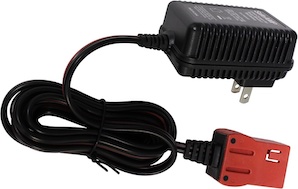
-----
How to size rectifiers and battery chargers for electroforming
Jewelry students want to make an electroplating rectifier
Q. Hi,
I am a jewelry student and to make a little extra money have been making copper chain (i.e., bracelets, anklets, and keychains). The clasp I would like to use for my bracelets is not copper and I would like to be able to electroplate them, but do not have access to a rectifier. If anyone could give me instructions on how to turn a battery charger ⇦ on eBay or Amazon [affil link] into a working rectifier or even to build one from scratch it would be much appreciated. (I have worked with electronics before and feel comfortable soldering)
Thank you!
Adam Mendelstudent - Atlanta, Georgia, USA
2004
A. There's more to plating and to rectifiers than most people think, Adam, but for you to to turn a battery charger into a fixed voltage rectifier you should connect it to a 6-volt battery to dampen out the ripple.
If you intend to sell anything you electroplate, better look into EPA 40CFR 433 because electroplating was the nation's first categorically regulated industry; and while the EPA is unlikely to find and hassle a hobbyist, if a neighbor complains you'd be in trouble if you are selling electroplating services or electroplated items.

Ted Mooney, P.E.
Striving to live Aloha
finishing.com - Pine Beach, New Jersey
Ted is available for instant help
or longer-term assistance.
A. What Ted Mooney says is true.
On the other hand, copper electroplating for non critical applications can be very forgiving of ripple in the DC power supply, as long as the voltage never goes negative. (In that case you would be experimenting at the cutting edge of electroplating technology - pulse reverse plating *L*.) Have you tried plating with the battery charger as-is ? You may get acceptable results without any modifications. As with any plating process, you will need to adjust current to prevent too high a current density which will give poor appearance or burning. With a non adjustable power supply like a battery charger (or you can even use a car battery if the charger gives too much ripple) you adjust the current by setting the distance between the part and the anode. Further apart means less current, slower plating, and generally a more uniform result.
Kim L. Ground- Clearwater, Florida, USA
2005
![]() Thanks Kim, great suggestion about increasing the distance between anode and cathode to reduce the current.
Thanks Kim, great suggestion about increasing the distance between anode and cathode to reduce the current.
Regards,

Ted Mooney, P.E.
Striving to live Aloha
finishing.com - Pine Beach, New Jersey
Ted is available for instant help
or longer-term assistance.
2007
A. The problem with using a regular battery charger, is that it switches on and off. Using a 12v car battery, it acts like a big capacitor.
Chris Hartmann- Westland, Michigan
A. I'd stick to 6 volts though. You can get a 6V lead-acid rechargeable battery for Powerwheels toys very cheap, and their little charger if you don't have a charger.
Regards,

Ted Mooney, P.E.
Striving to live Aloha
finishing.com - Pine Beach, New Jersey
Ted is available for instant help
or longer-term assistance.
Multiple threads merged: please forgive chronology errors and repetition 🙂
Can I use a motorcycle battery charger for electroforming?
Q. I am interested in setting up a home copperforming bath. To avoid the cost of a rectifier, can I use a 6-volt 1.25 amp or 6-volt .75 amp motorcycle battery charger? I have also seen inexpensive car battery chargers [battery charger
⇦ on
eBay or
Amazon [affil link]
] that have multiple settings (6/4/2 amps). I am just trying to keep my costs down and I would like to avoid the expense of a rectifier.
Thanks,
student/hobbyist - Phoenix, Arizona, USA
January 1, 2008
A. Six volts is high for copper plating and extremely high for electroforming, so I do not think that you will have much luck with taking the low budget way out. With extreme agitation, it might work.
James Watts- Navarre, Florida
January 3, 2008
A. Yes you can use it. Plating rectifiers are much better but expensive. You can even work with short connected chemical battery (that is original 19th century method). Some very good old books (Pfanhauser, Langbein, Gore, Urqhardt, Watt) on electroforming can be downloaded (free) from internet archive website.
According to R. von Neumann's book on jewelry making and design/electroforming chapter/ .
you must add variable rheostat (22 Ohm is ok) and ammeter/but you can work without it (ammeter!) -- just somewhat more complicated way. Copper sheet can be used as anode. Hope it helps (little bit more) and good luck!
- Cerovski vrh Croatia
January 4, 2008
January 10, 2008
A. You can use a battery, but you need to control the current applied to the workpiece (cathode). You will need a rheostat and an ammeter to control and measure the current. Although electroforming sounds very easy, in reality it is quite difficult; you will probably get good results when you first start, but as you use the copper solution, the quality of the deposit will deteriorate because you will not be controlling the electrolyte composition. I would recommend you look at the references given above and in other replies to similar questions on this site and find out how to measure and control the bath composition. You may want to set up a simple chemical analysis facility to ensure your solution is the correct composition.
It would also be a good idea if you had your battery on charge whilst you are doing your electroforming, then the battery will be acting as a power "stabiliser" and you will be more likely to get a constant current once you have set your rheostat to the required take-off current.
Remember that electroforming is not only about depositing metal, it also includes ensuring your mandrel/template is adequately pretreated to ensure you get good and consistent deposition.
Regarding the anode, copper sheet will be OK, but you should at least bag it to prevent any undissolved particles escaping into the electrolyte - if they do, you will get a rough deposit on your cathode.
You will also need to agitate either the workpiece or the electrolyte to make sure you get good solution movement.
Finally, you need to ensure you can dispose of your waste solutions. This includes both your cleaners and copper electrolyte. You MUST NOT tip them down the drain because they will be harmful to the environment and anyone who is unfortunate enough to come into contact with your waste stream. Such legal disposals can be quite expensive to arrange, but to do it illegally can (and should) result in much heavier fines and possible imprisonment (at least in the UK!).
Once you have got a good setup and complied with your local waste regulations, good luck with your electroforming and long may you have fun doing it.

Trevor Crichton
R&D practical scientist
Chesham, Bucks, UK
What's the right size rectifier for copper electroforming?
Q. I am building a new copper electroforming tank and want to make sure I get the correct rectifier/plating machine. I built an 8 gallon tank using a 10 amp precision control rectifier a while ago for jewelry and small sculptural objects and it has worked like a charm. I am now looking at taking my work to a larger scale. The new larger tank holds 45 gallons of electrolytic solution and 6 monster copper anodes. I assume that a tank of this scale will require a significantly larger electric load. Does anyone have any suggestions on what size rectifier I will need to be able to control the voltage and amperage on the low end that the electroforming process requires?
Michael ParrettArtist - Saint Louis, Missouri, USA
April 5, 2010
by Jay H. Newman

on eBay or Amazon
or AbeBooks
(affil link)
A. Hi, Michael. The surface area of the parts that you will be plating determines the rectifier size. If you are planning to put 6 times as many parts in your 45-gallon tank as in your 8-gallon tanks, the required amperage will be 6 times as high. If you were actually drawing the full 10 amps previously, you will now be drawing 60 Amps (although that sounds high). The voltage will be essentially the same as before, and I imagine it was less than 6 volts. Good luck.
Regards,

Ted Mooney, P.E.
Striving to live Aloha
finishing.com - Pine Beach, New Jersey
Ted is available for instant help
or longer-term assistance.
Controlling amperage in Electroforming
January 26, 2011To whom it may concern, I am interested in electroforming nature. I recently purchased a plating station - specifications are:
Power Supply 230 Vac
Amperage 2.2 A
Watt 500 Watt
Plating lines 2
Plating line parameters 0-12 Vdc / 0-10 Adc-7V
Heater 200 Watt / 230 Vac
Air pump 72 L/Hour
CRS 1
CRS speed (RPM) 2-4
Horizontal tank 3 (150 W x 70 D x 70 H mm)
Vertical tank 3 (95 W x 80 D x 205 mm)
Dimensions of station (mm) 315 W x 335 D x 280
It allows plating/forming of gold, rhodium, copper, nickel, silver, bismuth, and others.
My question is as follows:
How can I control the amps on my unit to do electroforming at 1/10 amp per sq inch? I saw a 'fine tuner' that plugged into the 'positive' anode of the rectifier, then you attached your anode into this unit; but could not afford to buy it from America as the shipping was $180 USD! Please tell me what this unit is called and where I can buy one. I am based in Greece.
Thanking you in advance.
Hobbyist - Mitilini, Lesvos, Greece
A. Hi, Marianna.
Please google "plating rheostat" -- I think this is what you are envisioning. Good luck.
Regards,

Ted Mooney, P.E.
Striving to live Aloha
finishing.com - Pine Beach, New Jersey
Ted is available for instant help
or longer-term assistance.
January 27, 2011
Adjusting the amps on a DC power supply for electroforming
Q. I have a fairly basic question about the power supply we'll be using for electroforming. We have a 5V 200A DC powertec supply, and would like to know two things: 1] what's the best way to meter the amps, and 2] is it possible to adjust the amps on this particular supply. I know this is a little off the electroplating/forming track, but if you are able to shed any light on either question it'd be greatly appreciated.
I've pasted a few pictures of our unit below - as one of them shows, there is a "V adjust" dial - do you happen to know if adjusting the volts affect the amps as well? Or is there a device that connects to the molex 9-pin plug that allows you to meter and adjust the output?


Otherwise, if you have any suggestions you think we should consider, please feel free to let me know.
Gaelen Armstrong- Fairfield, Iowa, USA
August 17, 2014
A. Hi Gaelen. If you have no instructions or schematic for this power supply it will be very hard to get it to do anything. We can see the connection posts for the 200 Amp output and two of the three 10 Amp outputs (the other one might be cropped off the left side of your top photo?) but we have no information at all about how those outputs are controlled -- just the assumption that if you connect something to the 9-pin and 6-pin molex connectors, something will happen. There might be pins for a voltmeter and an ammeter in each of the outputs, and additional pins for feedback of some sort but it's hard to guess.
But you cannot independently control voltage and amperage anyway. Ohm's Law tells us that the current will be V/R, or the voltage will be IR.
Regards,

Ted Mooney, P.E.
Striving to live Aloha
finishing.com - Pine Beach, New Jersey
Ted is available for instant help
or longer-term assistance.
August 2014
January 5, 2016
Q. Hi,
I'm looking to electroplate brass rings with gems glued on top of then (though I believe this is then electroforming as the copper builds on the glue and around the ring and gem?). What I'd like to know is:
What amp and volt size rectifier would be best? Some say 3 amp is enough for small scale Jewelry others insist on going up to 25 to 30amp. I can get a 3 amp 20 volt online for relatively cheap.
They have other smaller rectifiers, all have US plugs but do not state the plug voltage. I live in Australia and need to be sure I can use an adaptor (not a converter) to plug into a 220v outlet.
If I use brass rings do I need to paint then first with a copper conductive paint? What if I want to eventually do silver plating? Would brass be okay? I know I would need a different bath for that though just thinking of possibilities for the future.
Instead of using a copper conductive paint could I instead make my bath with copper sulphate, absorbing acid and distiled water mixed together? I have read that this works as a copper conductive paint when mixed with a watercolor medium but could I just use it as the bath instead?
Lastly, do I need to agitate the bath continually? I wouldn't mind a slightly organic look and have read that without agitation this will happen but I do not know to what extent.
Many thanks!
Rachel
- Southport, QLD, Australia
February 4, 2016
A. Hi Rachel,
The size of rectifier, in terms of current, depends on the area the work to be plated and the current density required. The current density is measured in amps per unit area. I know the in Oz, you have chosen the metric system so I'll use amps per square decimetre. Typical plating CDs are 1 - 4 amp/dm2. So you need work out the area to be plated and find the optimum CD of your plating process. Then workout the current that you need. As an example:
CD 2 amp/dm2
Area 3 dm2
Current 2 x 3 = 6 amps
Voltage is important too. You must be able to vary the voltage to set the current to the wanted value. Only a few volts will be required: a fixed voltage of 20 volts would be far, far too high.
It is vital for safety reasons to use the correct mains input to the power supply. Some small power supplies accept a wide range of voltage inputs but most do not. I am a little surprised that the input voltage is not marked on the unit.
The brass rings will not need a conductive paint but will be ready to be copper plated after cleaning. Likewise silver plating. One caution regarding silver. Thin coatings will migrate into copper or brass causing severe discolouration. You either need about 25 microns or a "barrier layer" of a suitable metal to prevent migration. There is a lot information on the subject on this site.
I don't know why you need a conductive paint and have no idea if the mixture you propose would work. Don't know what "absorbing acid" is. Should it read "ascorbic acid"?
It is usually desirable to have agitation. It is necessary to replace the metal plated at the cathode. Agitation greatly helps. If fresh metal is not brought to the surface we get a coarse, powdery deposit called "burning". I wouldn't call it a "slightly organic look"!
Is this of any help?
Harry

Harry Parkes
- Birmingham, UK
A. Hi Rachael
H hope you realise that almost all silver plating is done from a cyanide solution.
There are non-cyanide processes but they require close chemical control and may not be any less toxic.
You may not even be able to buy cyanides, but if you do, you will need an antidote kit, training to use it and never work alone.
Lots of other considerations; safe storage, disposal, local legislation etc.
Not trying to scare you but these are serious chemicals

Geoff Smith
Hampshire, England
February 5, 2016
Q. I have a BK precision model 1601 dc power supply; it has a meter range where you can choose 0-50 V and 0-25 Vand it looks like it's only a 2 amp system. I want to make a 3 gallon bath for copper plating, putting at least 6 pendants 3 inches by 3 inches down the bar.
When trying to calculate what I would need in a rectifier it came out to 50 amp system for a 36 sq inches of area to cover with the 3 gal. bath.
my question is this bk is not powerful enough for what I need is it? what size rectifier would I need to be able to plate several large pendants at one time?
- key largo, Florida
March 26, 2016
A. Hi Josette. Are you plating only one side of the pendants and, despite being about 3" x 3", their surface area is only actually 6 square inches each? (If there were 6 pendants of 2 sides at 3" x 3", that would be 108 square inches, rather than 36 square inches.)
Even still, a 2-amp power supply would give you 2.67 ASF which just might be barely enough. If the area is correctly 36 square inches, you could do 8 ASF, which should be more than enough. If the area is 72 square inches (if you forgot the back side in your calculation but will be plating it), you would be at 4 ASF and I think that should do it. I don't know how you calculated 50 Amps, but it wasn't right :-)
Regards,

Ted Mooney, P.E. RET
Striving to live Aloha
finishing.com - Pine Beach, New Jersey
Ted is available for instant help
or longer-term assistance.
March 2016
Q. Hi,
Can someone explain what to look for when buying a rectifier?
I will be using it strictly for electro plating copper.
Thanks
- Tampa, Florida, US
October 23, 2017
A. Hi Scott. Copper plating rectifiers can range from very inexpensive hobbyist units to industrial ones costing tens of thousands of dollars each. What is probably most important for a hobbyist is that the size (voltage and amperage) is right and that it actually be designed for use as a plating rectifier.
Regarding the size, it depends on whether you will be doing electroforming or decorative electroplating. If electroforming, you probably will be using something like 2 Amps per square foot of surface area of your components; if you are doing decorative electroplating, probably 10X that current. For hobbyist electroplating it's hard to imagine a need for more than 6 volts. The rectifier should allow you to choose between voltage control and amperage control; that is, you should be able to choose any voltage you wish or to flip a switch and be able to choose any amperage you wish.
Regards,

Ted Mooney, P.E. RET
Striving to live Aloha
finishing.com - Pine Beach, New Jersey
Ted is available for instant help
or longer-term assistance.
October 2017
October 23, 2017
Q
Ted,
Thanks for your quick response. This is only for plating, specifically barrel plating. That being said would the same rule of thumb (approx. 20 Amps per 1 sq. ft of surface area) from your post still apply? Or does barrel plating amperage differ from direct connection amperage?
Thanks
- Tampa, Florida, US
(affil links)

free pdf is currently available from academia.edu
Hi Scott. Please detail your actual situation: Are you a production plating shop, or a hobbyist, or a captive machine shop venturing into plating, or other? Is the plating line already existing and you want to add a copper plating station to it? How big of a plating barrel are you planning to use? Do you know the load size (weight and/or surface area)? What copper plating process: cyanide, bright acid copper, copper pyrophosphate? Will you be using a proprietary plating process? (Usually the supply company offers a technical data sheet that tells you typical rack plating and barrel plating current density).
The short answer is that barrel plating generally employs much lower current density than rack plating, but higher voltages. The longer answer is that plating barrels can range from 2" dia x 4" long to almost 2' dia x 4' long, and Q & A forums like this can often answer very specific questions or refer you to books or articles for more general answers, but due to time & space constraints they usually cannot directly answer generalized questions without specific details. Thanks and good luck.
Regards,

Ted Mooney, P.E. RET
Striving to live Aloha
finishing.com - Pine Beach, New Jersey
Ted is available for instant help
or longer-term assistance.
October 2017
Q, A, or Comment on THIS thread -or- Start a NEW Thread
Disclaimer: It's not possible to fully diagnose a finishing problem or the hazards of an operation via these pages. All information presented is for general reference and does not represent a professional opinion nor the policy of an author's employer. The internet is largely anonymous & unvetted; some names may be fictitious and some recommendations might be harmful.
If you are seeking a product or service related to metal finishing, please check these Directories:
Finishing
Jobshops
Capital
Equipment
Chemicals &
Consumables
Consult'g,
& Software
About/Contact - Privacy Policy - ©1995-2025 finishing.com, Pine Beach, New Jersey, USA - about "affil links"


